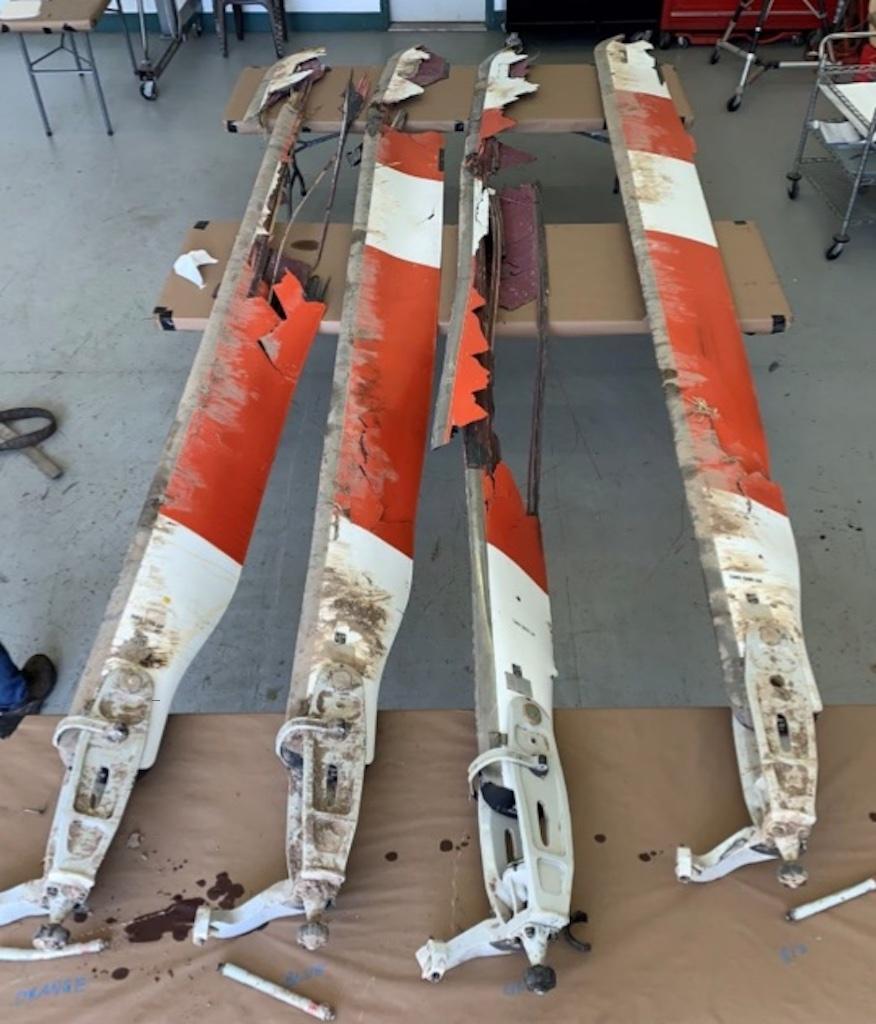
Examination of the Bell 429’s main rotor blades revealed impact marks.
NTSB accident reports and recommendations of manufacturers and regulators contain insights that should be considered in flight training of vortex ring state (VRS) recovery of helicopters as well as other abnormal and emergency conditions.
The NTSB noted the likelihood that the flight instructor in the Bell 429 accident described earlier in this article did not provide adequate information to the pilot trainee on how he would receive training for VRS, to include how they would identify, enter, and exit VRS.
Additionally, the investigation of the Bell 429 accident determined that the rapid cyclic input would not have allowed sufficient time for the airframe attitude to adjust to the main rotor inputs from the cyclic because of the rapid aft cyclic movement.
Airbus Helicopters has performed tests to gather data for a more complete understanding of the aerodynamic loads on the helicopter. Airbus Helicopters does not consider VRS as a normal part of the flight domain of any rotorcraft. Dynamic loads on some components of the rotor system increase significantly in full VRS and are not completely taken into account in the components’ service life. Airbus Safety Information Notice No. 3463-S explicitly recommends against placing the helicopter in fully developed VRS.
In January 2024, Robinson Helicopter Co. amended its flight manual to reflect this same limitation on VRS training. It reads in part: “Do not allow the condition to develop beyond the initial indications and avoid large control inputs. Recovery should be initiated at the first sign.”
The two accidents discussed in this article also highlight a continuing issue for helicopter flight training. Emergency and abnormal procedures (EAP) training is risky, time consuming and expensive when done in an actual rotorcraft. In some emergencies it is necessary for the pilot to make an immediate and accurate control input to counter the abrupt undesirable motion of the rotorcraft.
How do we adequately prepare pilots for critical maneuvers and emergency procedures in all phases of flight and in less-than-ideal conditions without causing so many accidents?
Importance Of Simulators
The EASA leaflet “Training and Testing of Emergency and Abnormal Procedures” acknowledges that a number of helicopter accidents happen during the training or checking of EAP in which the instructor allowed the student to put the aircraft into a position where they were not able to recover it safely.
EASA’s Rotorcraft Safety Roadmap recommends, whenever possible, to train and check EAP in a flight simulator training device (FSTD). This would be particularly important for maneuvers with razor thin margins such as VRS, tail rotor malfunctions, or autorotations.
Unfortunately, the current reality in the industry is that suitable flight-training devices are not always available. This means that a considerable amount of EAP is still conducted in an actual helicopter.
The two fatal accidents unfortunately remind us that unrecoverable consequences can quickly occur if the pilot’s inputs are incorrect, insufficient, excessive, or poorly timed. There are flight conditions in which the primal control inputs must be exactly correct for that specific make/model of aircraft, as the consequences of less-than-correct control inputs will further aggravate the loss of control.
The correct control inputs must be made immediately, or else the condition of the aircraft will exceed the limits for recovery and potentially cause a catastrophic structural failure.
Training For Recovery From Vortex Ring State, Part 1: https://aviationweek.com/business-aviation/safety-ops-regulation/traini…






Comments